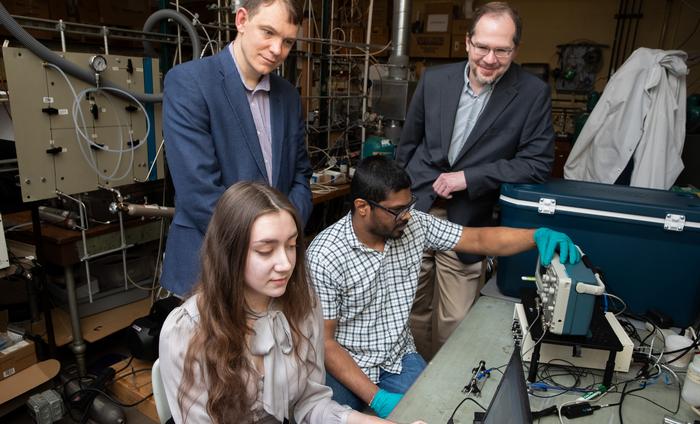NJIT research team discovering how fluids behave in nanopores with NSF grant
A research team from New Jersey Institute of Technology is uncovering mysteries surrounding fluids in nanoporous materials, and has been recently awarded a grant from the National Science Foundation (NSF) to support this research. Credit: NJIT A research team from New Jersey Institute of Technology is uncovering mysteries surrounding fluids in nanoporous materials, and has been recently awarded a […]

A research team from New Jersey Institute of Technology is uncovering mysteries surrounding fluids in nanoporous materials, and has been recently awarded a grant from the National Science Foundation (NSF) to support this research.

Credit: NJIT
A research team from New Jersey Institute of Technology is uncovering mysteries surrounding fluids in nanoporous materials, and has been recently awarded a grant from the National Science Foundation (NSF) to support this research.
The research is focused on the elasticity, or compressibility, of fluids in these nanopores. Understanding the elastic properties of fluids has significant implications across multiple disciplines. Engineering applications, geological exploration, materials science and environmental studies stand to benefit from insights gained through this research.
While elasticity of fluids is well understood in bulk, in nanoporous materials at the microscopic level the fundamental properties of fluids are different, according to Gennady Gor, associate professor of chemical and materials engineering at NJIT and the principal investigator.
The primary objective of this research program is to develop a molecular theory capable of quantifying the effects of confinement on the elastic properties of fluids and utilize this theory to predict the transfer of energy — wave propagation — in fluid-saturated nanoporous materials.
Moreover, this research could affect the knowledge base of thermodynamic understanding and prediction. All thermodynamic properties have a relation to one another, including compressibility. This “equation of state” is a mathematical relationship that describes the state of a system in terms of its thermodynamic properties such as pressure, volume and temperature.
“Compressibility is one of the parameters which goes into the equation of state and if we see a deviation in compressibility, the whole equation of state should be changed,” said Gor. “The predicting of all thermodynamic properties should be revisited and this is extremely important for broader applications where thermodynamics of fluids and pores is considered.”
The research team will employ a combination of molecular-scale modeling and experimental techniques to investigate the effects of confinement on fluid elasticity. Molecular-scale modeling efforts will focus on studying hydrocarbons confined in pores of various sizes and surface properties, while experiments will be conducted using model materials such as porous glasses and porous carbon with well-defined pore sizes.
The experimental team works closely with the modeling team to test the validity and provide feedback for model evolution. In order to scale up molecular-scale models to simulate much larger systems over longer periods of time, certain simplifications and assumptions need to be made.
“So far, we are gratified to see that experimental measurements reproduce the predictions made by the model very well. However, figuratively speaking, we are still at the mouth of a cave and who knows what treasures are hidden inside,” said Alexei Khalizov, co-principal investigator and associate professor of chemistry and environmental science at NJIT.
To test the models, researchers will fill a known fraction of the nanopores with fluid then probe the sample with an ultrasonic pulse. Their upgraded experimental setup allows for precision dosages of vapor from any fluid, previously they were only testing water, and fully automated experiments. According to Khalizov, the automation is a crucial element of the experiment because each point on the saturation curve sometimes may take an entire day; some samples have a high specific surface area and the diffusion in nanopores is slow.
The team’s lab will house vacuum-sealed, temperature-controlled chambers to ensure a consistent environment, which builds off of proof of concept developed by an NJIT alumnus, Jason Ogbebor, now pursuing a Ph.D. at MIT. Gor credits much of the origins of this project from the NJIT faculty seed grant and summer fellowship, which supported Jason’s research as an undergraduate. Ashoka Karunarathne, a postdoctoral research associate, joined the team and has been instrumental in expanding the project.
“Fluid elasticity is a crucial parameter that influences how fluids respond to changes in pressure, temperature, and other environmental factors,” stated Gor. “Our findings will not only advance fundamental understanding but also have practical applications in diverse fields such as hydraulic systems design, natural resource exploration, energy-storage devices, new technologies at the water-energy nexus and chemical and biological separations.”
The research builds upon earlier publications and will have implications for petroleum and water resource exploration, as well as greenhouse gas sequestration efforts. By studying the elastic properties of hydrocarbon fluids in nanopores, the research team aims to develop new theoretical models that will aid in these critical areas.
“We are excited about the potential of our research to contribute to advancements in fundamental science and practical applications. By unraveling the mysteries of fluid behavior in nanoporous media, we aim to pave the way for innovations that can address pressing challenges across multiple domains,” said Gor.
The NSF grant will support this research project over the next three years, enabling the research team to make significant strides in understanding the complex interplay between fluid confinement and elasticity in nanoporous media.
What's Your Reaction?

































